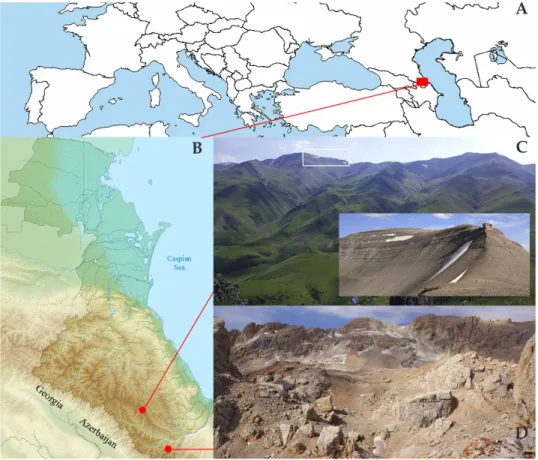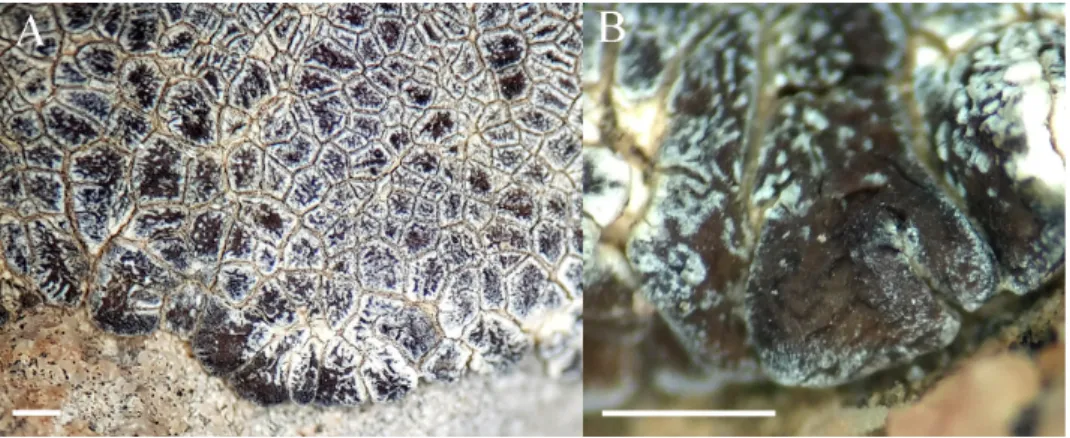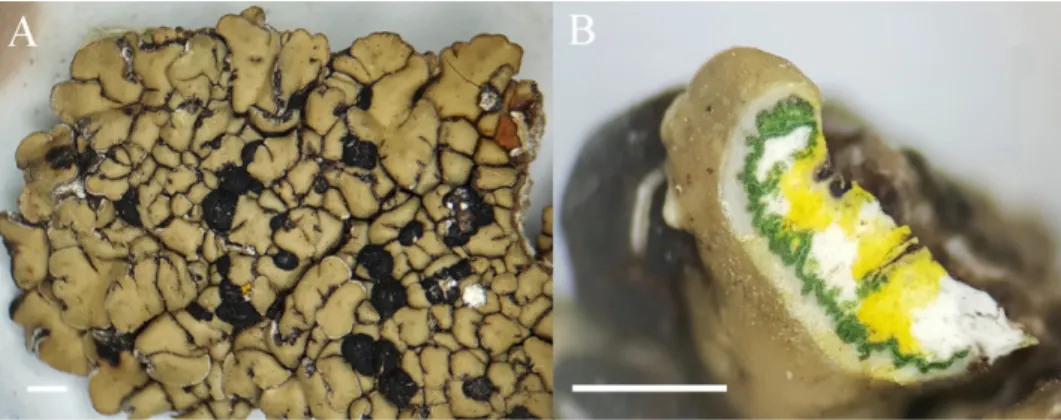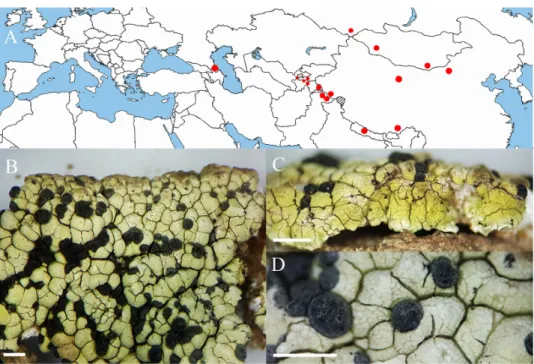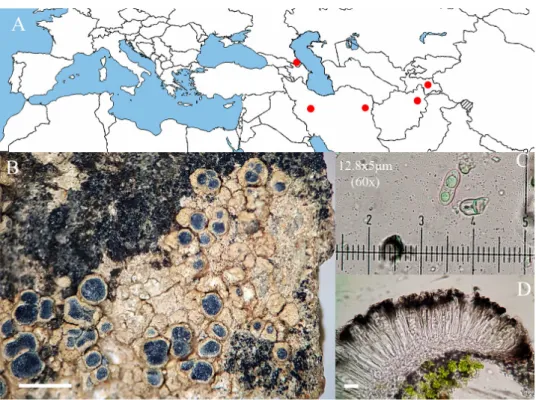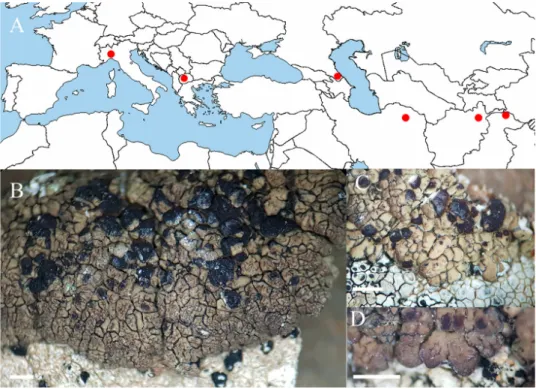NEW AND RARE LICHENS FOR RUSSIA AND THE CAUCASUS FROM HIGH MOUNTAINOUS DAGESTAN (EAST CAUCASUS)
A. B. Ismailov1 and G. P. Urbanavichus2
1Mountain Botanical Garden, Dagestan Scientific Centre, Russian Academy of Science 367000, Makhachkala, M. Gadjieva str., Russian Federation; E-mail: i.aziz@mail.ru
2Institute of the North Industrial Ecology Problems, Kola Science Centre Russian Academy of Science, 184209, Apatity, Akademgorodok, 14a, Russia Federation
(Received 19 February, 2018; Accepted 3 September, 2018)
Five species of lichenized ascomycetes are reported from high mountainous Dagestan.
Acarospora laqueata, Lecania ochronigra and Protoparmelia placentiformis are new to Russia and the Caucasus (the last two). Anamylopsora pulcherrima is the first record of the genus and species for the North Caucasus. Buellia centralis is the first record for the Caucasus and second for Russia. Our records considerably extended information about geography and ecology of presented species especially the very rare species Buellia centralis, Lecania ochronigra and Protoparmelia placentiformis. The characteristic features of specimens with information of their morphology, anatomy, ecology and world distribution are given.
Key words: Caucasus, floristical studies, lichens, new records, rare species, Russia
INTRODUCTION
Exploration of biodiversity in mountainous ecosystems is an important fundamental direction. Dagestan is located in the Caucasus biodiversity hot- spot. It is the southernmost part of Russia, situated along the western shore of the Caspian Sea (Fig. 1A). Most of the republic is mountainous, with the Cau- casus Mountains on the south. The highest point is the Bazardyuzi Mountain (4466 m). The climate is hot and dry in summer but the winters are hard in the mountain areas. Large areas of the mountains on the South are devoid of veg- etation, but through the gorges of the rivers birch and pine forests grow. In semi-arid conditions in the northern part of the republic is dominated by Arte- misia sp. Foothills are covered by communities of Quercus petraea, Q. pubes cens and by steppe vegetation in the lower parts (Akayev et al. 1996).
The Republic of Dagestan is intensively studied in terms of lichenofloris- tical surveys. Due to its diverse geomorphology and altitudinal range (from –26 to 4466 m a.s.l.), it harbours a species-rich mosaic of vegetation ranging from xerophilous to alpine (e.g. mountainous dry pine forests, mesophytic deciduous forests, steppes, and semi-deserts) above which is subnival and ni- val zone with glaciers and snowfields. This is reflected on the lichen diversity.
The lichens of the subnival and nival zones are absolutely not studied here. This is a gap in knowledge that needs to be filled. The present paper adds further information to our knowledge on lichens of high mountainous Dagestan and the entire Caucasus.
MATERIAL AND METHODS Study area
The study areas are situated in high mountainous part of Dagestan (Fig.
1B). The first site studied, i.e. the northwestern part of the Samurskiy ridge (the summits are the Kuru-dag (3831 m) and the Kurapdag (3770 m) mountains), is located in sand-slate highlands (Fig. 1C). The climate is temperate continen- tal; the average annual air humidity is 66%; the average annual rainfall is 600
Fig. 1. The study area. A = location of Dagestan; B = investigated sites; C = west part of the Samurskiy ridge with the Kurapdag peak; D = east slope of the Shalbuzdag Mountain
A
B C
D
mm; the average annual temperature is 6.5 °C with absolute minimum of –26
°C in January (average is –4 °C), and absolute maximum of 38 °C in August (average is 12.5 °C). Most of the territory are covered by alpine and subalpine meadows, but above 3000 m the meadows are changed by rocky wasteland.
The second site studied is the Shalbuzdag Mountain. It is a limestone rocky mountain with the highest point of 4142 m (Fig. 1D). The mountain slopes are covered by subalpine and alpine vegetation. Above 3000 m the continuous herbal and soil cover is absent. Higher than 3600 m mainly on northern slopes the snowfields and small glaciers are preserved. The temperature and humid- ity indicators are similar to the first site (Akayev et al. 1996).
Methods
Specimens were collected during a short field work on spurs of the Sam- urskiy ridge and the Shalbuzdag Mountain in July 2017. Morphological and microscopical investigations were done by light microscopy and with the use of routine spot tests (KOH, IKI, C6H4(NH2)2, Ca(ClO)2, HNO3 and UV light) in Komarov Botanical Institute RAS. The geographical coordinates (WGS-84) and altitudes of each locality were measured by hand-held GPS navigator.
The examined materials are deposited in the herbarium of Mountain Botani- cal Garden of DSC RAS (DAG).
RESULTS
Acarospora laqueata Stizenb., in Flagey, Revue Mycol. 14: 73 (1892) (Fig. 2)
The specimen forming a rosette thallus up to 6 cm diam., areolate, with distinct brown marginal lobes. Upper surface with strong white or grey-white pruina. Lobes up to 2.3 mm long and 1.2 mm wide, adpressed, expanded on the ends and incised, often wrinkled and without pruina. Areoles angular, up to 1 mm wide, with white pruina mainly on margins of areoles. Apothecia im- mersed 1–2 per areole, without thalline margin. Disc up to 0.5 mm diam., con- cave, rounded or angular, reddish brown. Epihymenium light brown; hyme- nium hyaline 120 µm; hypothecium colourless or greyish 100 µm, granular;
exciple inconspicuous. Asci 72–85 × 15–17 µm, 100-spored. Ascospores 4–5.5 × 2–3 µm, ellipsoid. All spot tests are negative. Hymenium I+ blue.
Differs from A. cervina by the distinctly lobed thallus and a protruding rim along the lobes and areoles formed by the densely white pruina.
Specimen examined: Russia, Dagestan, Dokuzparinkiy district, Shalbuzdag Moun- tain, оn calcareous rocks in subnival zone, N 41° 48’ 18.5”, E 47° 22’ 48.6”, alt. 3600 m, coll.:
A. B. Ismailov, 24.07.2017 (DAG 0962).
The species was described from Algeria and widespread in dry conti- nental areas from the Iberian Peninsula to the Tian Shan. It is the first record for Russia and the North Caucasus. Nearest location known from Armenia (Harutyunyan and Mayrhofer 2009).
World distribution: Europe (France, Italy, Spain, Switzerland), Asia (Ar- menia, Syria, Iraq, Israel, Jordan, Kyrgyzstan, Tajikistan, Turkey, Turkmeni- stan), North Africa (Algeria, Morocco, Tunisia) (Harutyunyan and Mayrhofer 2009, John et al. 2004, Temina et al. 2005).
Anamylopsora pulcherrima (Vain.) Timdal, Mycotaxon 42: 250 (1991). – Lecidea pulcherrima Vain., Acta Horti Petropolitani 10 (2): 561 (1888)
(Fig. 3)
Detailed description is given by Timdal (1991). Our specimen has a typi- cal characteristic thallus: upper surface cream-coloured, shiny, epruinose;
central squamules up to 2 mm diam., marginal lobes crenulate, up to 3 mm width, more or less white pruinose mainly on tips of lobes. Single apothecia up to 1.2 mm diam., sometimes forming conglomerates up to 6 mm diam. Epi- hymenium brownish; hymenium colourless, 75 µm; hypothecium pale brown with crystals. Ascospores 8–11 × 6.5–7.5 µm. Cortex K+ orange, C–, Pd–. Me- dulla K–, C–, Pd+ yellow.
Positive medulla reaction with Pd, negative cortex reaction with Pd and cream-coloured thallus differ the Dagestan specimen from the Siberian one.
Our specimen is similar to the one described from Turkmenistan.
Fig. 2. Acarospora laqueata. A = thallus; B = marginal lobe. Scale bars: 1 mm
Specimen examined: Russia, Dagestan, Agulskiy district, neighbourhood of Chirag village, on carbonised sandstone rocks among alpine vegetation, N 41° 48’ 41.6”, E 47° 25’
17.9”, alt. 2400 m, coll.: A. B. Ismailov, 20.07.2017 (DAG 0961).
The species was described from Turkmenistan. It is the first record of the genus and species for the North Caucasus. Nearest location known from South Azerbaijan (Barkhalov 1964). In Russia this species is known from Si- beria and from the Far East (Urbanavichus 2010). It has wide distribution in continental areas of the Northern Hemisphere.
World distribution – North America (Alaska); Asia: Armenia, Azerbai- jan (as Psora pulcherrima), Russia, Tajikistan (as Psora pulcherrima), Mongolia, China, Nepal (Barkhalov 1964, Harutyunyan and Mayrhofer 2009, Kudratov and Mayrhofer 2002, Timdal 1991).
Buellia centralis H. Magn., Lichens from Central Asia 1: 147 (1940) (Fig. 4)
Thallus crustose, areolate, deeply cracked, with marginal lobes. Cor- tex yellowish green, scabrous, slightly pruinose. Areoles 0.4–0.7 mm wide, convex, some cracked. Apothecia 0.3–1 mm in diam., mainly on margins of areoles in the cracks, young ones angular, mature ones roundish, often with slightly whitish pruinose disc. Epihymenium brownish with yellow crystals;
hymenium colourless or light brown, 80 µm high; hypothecium dark brown.
Asci 43 µm. Ascospores Buellia-type, 13–15(17.5) × 6.2–7.5 µm. All spot tests negative.
Specimens examined: a) Russia, Dagestan, Agulskiy district, neighbourhood of Chi- rag village, on carbonised sandstone rocks among alpine vegetation, N 41° 49’ 29.2”, E 47°
Fig. 3. Anamylopsora pulcherrima. A = thallus; B = reaction of medulla with Pd. Scale bars: 1 mm
25’ 53.6”, alt. 2650 m, coll.: A. B. Ismailov, 20.07.2017 (DAG 0963); b) Ibid., on carbonised sandstone rocks among alpine vegetation, N 41° 48’ 41.6”, E 47° 25’ 17.9”, alt. 2400 m, coll.:
A. B. Ismailov, 20.07.2017 (DAG 0968).
A rare species described from China. It is the first record for the Cauca- sus and the second for Russia. The location in Dagestan is the westernmost in its world distribution. Nearest locality known from Tajikistan (Obermayer et al. 2004).
World distribution – Asia: Russia (Altai: Sedelnikova 2013), Tajikistan, Mongolia, Pakistan, China, Nepal (Obermayer et al. 2004).
Lecania ochronigra J. Steiner, Ann. Mycol. 8: 236 (1910) (Fig. 5)
Thallus small, up to 1 cm diam., cracked-areolate, thin, cream coloured to ochraceous. Apothecia 0.3–0.7 mm diam. immersed in areoles, with distinct thallus margin. Disc black with slightly white pruina. Epihymenium 20–25 µm, dark brown, K+ violet, HNO3+ red; hymenium not inspersed, 47–52 µm, colourless; hypothecium 28–33 µm colourless. Asci 5–8 spored. Ascospores 1-septate, 10–13 × 5–6 µm. All spot tests on cortex are negative.
Fig. 4. Buellia centralis. A = world distribution; B = habitus; C = marginal lobes; D = part of thallus with apothecia. Scale bars: 1 mm
Specimen examined: Russia, Dagestan, Agulskiy district, neighbourhood of Chirag village, on sandstone rocks among alpine vegetation, N 41° 49’ 02.5”, E 47° 25’ 46.3”, alt.
2550 m, coll.: A. B. Ismailov, 20.07.2017 (DAG 0964).
Very rare Asian species described from Iran and known only from some localities. It is the first record for Russia and for the Caucasus. There is the northernmost location of the species in its world distribution. Nearest loca- tion known from Iran (Steiner 1910).
World distribution – Asia: Iran (Steiner 1910), Tajikistan (Kudratov and Mayrhofer 2002), Afghanistan (Poelt and Wirth 1968).
Protoparmelia placentiformis (J. Steiner) Poelt, in Poelt and Leuckert, Nova Hedwigia 52 (1–2): 59 (1991). – Lecanora placentiformis J. Steiner,
Ann. Mycol. 8: 233 (1910) (Fig. 6)
Thallus areolate (like squamulose), more or less placoid, 2–3 cm diam., light brown. Central areoles 0.5–1.2 mm diam., lateral elongated up to 1.8
Fig. 5. Lecania ochronigra. A = world distribution; B = habitus (scale bar 1 mm); C = as- cospore; D = section of apothecia (scale bar 15 µm)
mm long. Apothecia lecanorine up to 1.5 mm diam. Epihymenium brownish;
hymenium 42 µm, colourless; hypothecium colourless. Asci 30 µm, 8-spored.
Ascospores simple, 8–10 × 5–6 µm. Cortex K+ yellow turning to red, C–, Pd–.
Medulla Pd+ yellow to light orange, C–, K–.
Specimens examined: a) Russia, Dagestan, Agulskiy district, neighbourhood of Chi- rag village, on carbonised sandstone rocks with Dimelaena oreina and Aspicilia sp., among alpine vegetation, N 41° 48’ 41.6”, E 47° 25’ 17.9”, alt. 2400 m, coll.: A. B. Ismailov, 20.07.2017 (DAG 0965); b) Ibid., on sandstone rocks with Aspicilia sp., among alpine vegetation, N 41°
49’ 02.5”, E 47° 25’ 46.3”, alt. 2550 m, coll.: A. B. Ismailov, 20.07.2017 (DAG 0967).
Very rare species described from Iran and occurs in arid mountainous parts of South Europe and Asia where known only from some localities. It is the first record for Russia and the Caucasus. Nearest location known from Iran (Szatala 1940).
World distribution – Europe: Italy (Nimis 2016), Macedonia (Poelt and Leuckert 1991); Asia: Iran (Szatala 1940), Afghanistan (Poelt and Wirth 1968), Pakistan (Poelt 1961).
Fig. 6. Protoparmelia placentiformis. A = world distribution; B = habitus; C = part of thallus;
D = lateral lobes. Scale bars: 1 mm
*
Acknowledgements – This work was supported by a grant from the Russian Foundation for Basic Research (no. 15-29-02396) “North Caucasian Lichen Flora: taxonomic structure, diversity, specificity, systematic of individual taxa and contribution to the diversity of the lichen flora of Russia”.
REFERENCES
Akayev, B. A., Atayev, Z. V., Gadzhiev, B. S., Gadzhieva, Z. Kh., Ganiyev, M. I., Gasangu- seinova, M. G., Zalibekov, Z. M., Ismailov, Sh. I., Kasparov, S. A., Lepekhina, A. A., Masayev, V. O., Rabadanov, R. M., Solovyov, D. V., Surmachevskiy, V. I., Tagirov, B.
D. and Eldarov, E. M. (1996): Physical geography of Dagestan. – School, Makhachkala, 382 pp. [in Russian]
Barkhalov, Sh. O. (1964): The lichen flora of the Talysh. – Doctor’s biol. sci. thesis, Baku, 48 pp. [in Russian]
Harutyunyan, S. and Mayrhofer, H. (2009): A contribution to the lichen mycota of Arme- nia. – Bibl. Lichenol. 100: 137–156.
John, V., Seaward, M. R. D., Sipman, H. J. M. and Zedda, L. (2004): Lichens and lichenicol- ous fungi from Syria, including a first checklist. – Herzogia 17: 157–177.
Kudratov, I. and Mayrhofer, H. (2002): Catalogue of the lichenized and lichenicolous fungi of Tajikistan. – Herzogia 15: 91–128.
Nimis P. L. (2016): The lichens of Italy. A second annotated catalogue. – EUT, Trieste, 739 pp.
Obermayer, W., Blaha, J. and Mayrhofer, H. (2004): Buellia centralis and chemotypes of Dimelaena oreina in Tibet and other Central-Asian regions. – Symb. Bot. Upsal. 34 (1):
327–342.
Poelt, J. (1961): Flechten auf dem NW-Karakoram im Rahmen der Deutschen Karakoram- Expedition 1959 von F. Lobbichler und Dr. J. Schneider gesammelt. – Mitt. Bot.
Staatssammlung München. 4: 83–94.
Poelt, J. and Leuckert, C. (1991): Der Formenkreis von Protoparmelia atriseda (Lichenes, Lecanoraceae) in Europa. – Nova Hedwigia 52(1–2): 39–64.
Poelt, J. and Wirth, V. (1968): Flechten aus dem nordostlichen Afghanistan gesammelt von H. Roemer in Rahmen der Deutschen Wakhan-Expedition 1964. – Mitt. Bot. Staats- sammlung München 7: 219–261.
Sedelnikova, N. V. (2013): Species diversity of lichen biota of the Altai-Sayan ecological region. – Plant Life of Asian Russia 2(12): 12–54. [in Russian]
Steiner, J. (1910): Lichenes Persici coll. a cl. Consule Th. Strauss. – Ann. Mycol. 8: 212–245.
Szatala, Ö. (1940): Lichenes. In: Rechinger, K. H, Baumgärtner, J., Petrak, F. and Szatala, Ö.: Ergebnisse einer botanischen Reise nach dem Iran, 1937. – Ann. Naturhist. Mus.
Wien. 50: 410–536.
Temina, M., Nevo, E. and Wasser, S. P. (2005): The lichen genus Acarospora in Israel and its vicinity. – Nova Hedwigia 80(3): 433–452. https://doi.org/10.1127/0029-5035/2005/0080 -0433
Timdal, E. (1991): Anamylopsora, a new genus in the Lecideaceae. – Mycotaxon 42: 249–254.
Urbanavichus, G. P. (2010): A checklist of the lichen flora of Russia. – Nauka, St. Petersburg, 194 pp. [in Russian]
